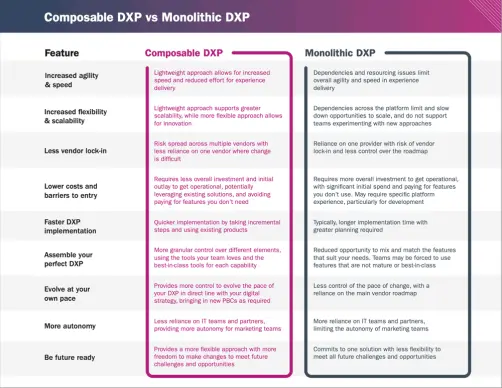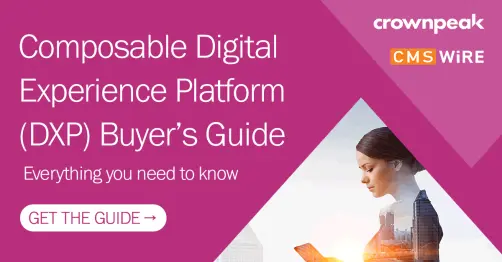What is a Composable DXP and Why do I Need One?
Delivering “best-of-breed" future-ready experiences at the speed of digital
A composable DXP delivers the capabilities of a traditional, monolithic digital experience platform – enabling the creation, management, delivery and optimization of highly personalized digital customer experiences – with a modular set of best-of-breed components that all work together seamlessly. A composable DXP gives marketers just the tools they need to create engaging, market-leading customer experiences, with the agility and flexibility to do it faster and at a lower cost.
Being an omnichannel marketer today can feel a lot like conducting a symphony… only you're constantly under pressure to come up with exciting new music: the whims of your audience are ever-changing and you're often called upon to perform with a limited number of musicians and instruments that are frequently out of tune.
Does this metaphor sound at all familiar?
If you are using a traditional, monolithic digital experience platform (DXP) , you probably have a big symphony that can play some nice pieces, but when it comes to wowing your audience with something fresh, you are limited to the instruments you already have, whether they’re the right ones or not.
This is the traditional model of most market-leading DXP platforms – the individual tools and capabilities are often challenging to use, limited in their flexibility, don’t play well with others and weigh you down, making it difficult to compose or perform anything new in a timely way. The audience yawns or seeks something more interesting elsewhere.
Now, to take this metaphor one step further… Marketing Maestro, imagine yourself standing at the podium, baton in hand, with the best instruments and every master musician you need – right there, available and ready – to play your latest masterpiece. Imagine, in crafting each new masterpiece, you have the ability to peer into the tastes of your audience in advance and know what musical experiences are likely to “wow” them. You can reconfigure your orchestra any time to have just the talents and sounds you need (without dragging along the entire symphony every time). And as you continue to innovate and grow, you can create your latest compositions with new instruments and performers – some you may not even anticipate you’ll need right now – and everyone gets along and plays in harmony.
This new symphony is the Composable DXP
Transitioning to a composable DXP strategy gives marketers unprecedented freedom, creativity and capabilities to address the needs of modern business.
In the new Composable DXP Buyer’s Guide , CMSWire sums up the situation:
““The sheer pace of change and the high expectations of B2C and B2B customers for targeted, personalized customer experiences across multiple channels means that the ability of marketing teams to respond rapidly and flexibly has never been more critical. Leaner approaches to delivering compelling digital customer experiences are ticking the boxes for under-pressure digital marketing teams. A composable DXP supports the agility that marketers need.””
According to Gartner® in the report " Adopt a Composable DXP Strategy to Future-Proof Your Tech Stack ,"
““By 2023, 60% of mainstream organizations will list composable business as a strategic objective and will use an increasing number of packaged business capabilities (PBCs)." [1]”
And,
“"By 2023, organizations that have adopted an intelligent composable approach will outpace competition by 80% in the speed of new feature implementation."”
Like a traditional DXP , a composable DXP provides an integrated set of technologies that support marketers in creating, managing, optimizing and delivering customized digital customer experiences. The difference – and it’s a big one – is that a composable DXP takes a modular (vs monolithic) approach.
According to Scott Brinker of chiefmartec.com, there are more than 8000 marketing technology solutions in the market today, providing an almost unfathomable range of capabilities for marketers. As opposed to being locked-in to a large, heavily IT-dependent, monolithic platform that doesn’t play well with other solutions, the modular approach of a composable DXP allows marketers to take advantage of multiple, separate, interchangeable, best-of-breed components that give them just the capabilities they need – with the confidence that the components will all work harmoniously.
With easy-to-assemble components including, hybrid headless CMS, content-driven commerce, digital quality and accessibility compliance, AI-powered personalization capabilities (and much more), a composable DXP like Crownpeak makes it easy for marketers to respond to changing needs and market trends. It enables them to create and deliver an endless variety of digital experiences in record time with the flexibility and agility that’s only possible with a composable architecture.

Composable DXP advantages for marketers
The relentless, real-time pace of marketing, with high customer expectations and omnichannel complexity, was already putting a strain on marketing departments, even before the pandemic hit. With the shift to more digital-first customer engagement and sales, marketers today are expected to do even more – and to do it faster, often with fewer resources. And the stakes are continuing to get higher: falling behind means leaving the field open for faster, more agile competitors.
A composable DXP relieves many of these pressures facing marketers today, enabling them to immediately reap significant benefits, including:
Speed and agility: Markets change quickly and new channels come online regularly. A monolithic DXP that takes weeks or months to run changes through IT slows everything down. A composable DXP with hybrid headless CMS makes it easier and faster to respond to customer expectations - across every channel – because marketers can do more on their own, without having to tap into IT at every turn.
Flexibility and scalability: A composable architecture makes the DXP much more flexible, fitting the right tools to the project with the ability to scale-up or scale-down as needs change – without the vendor lock-in of large, monolithic DXPs.
Better marketing ROI: Monolithic DXPs can be prohibitively expensive from the get-go, and they require more resources to maintain and upgrade – cutting into marketing ROI . A composable DXP allows marketers to get just the technology they need, without breaking the bank.
Creativity unleashed: Creativity is key when everyone's competing in a digital world. Customers can "channel surf" and compare brands with a few taps of a screen, and whoever creates the most engaging, personalized experiences will win the attention and long-term loyalty of customers. By putting more power in the hands of Marketing Maestros to create fresh, new experiences and roll them out quickly, composable DXPs support the creative side while helping marketers stay a step ahead of the competition.
The key advantages of a Composable vs Monolithic DXP approach are summarized in the graphic below:

Marketers know all of these things are critically important. A survey commissioned by Crownpeak and Vanson Bourne found that 73% of marketing and IT professionals believe they need to improve their speed of digital experience delivery. Missing opportunities is proving expensive; improving agility could result in a rise in revenue of up to 38%.

7 Steps to getting started on your composable DXP journey
So, Marketing Maestro, where do you begin? Here are seven key steps to help you get your work orchestrated like a finely tuned symphony using a composable DXP. Note, these steps are not necessarily linear – some may overlap.
1. Define your strategy and scope
Articulate what you are trying to achieve and define your strategy and specific goals, be they pain points to overcome or new channel opportunities to explore. Knowing the business case for why you want to implement a composable DXP will help you set the framework for planning, prioritization and implementation.
2. Involve stakeholders early
If a composable DXP is a new approach for you, you’ll need buy-in and input from your customer experience teams and IT partners. Building consensus early will help you succeed.
3. Do your research
Take time to research different capabilities across your current marketing technology stack and to identify the gaps. Ask your team which features they use often and which they would like to change. These types of questions will help you define which elements you’ll want to include as you compose your DXP .
4. Plan your perfect composable DXP ecosystem
Map out what your perfect composable DXP orchestra will look like – the features and capabilities you want and preferred solutions for each. From here, you can start to see the separate, independent PBCs that will make up your composable DXP .
5. Work out your roadmap, costs and any dependencies
Define a high-level roadmap and identify relative costs and dependencies, considering things like pricing, licensing agreements, data privacy and compliance regulations and any technical issues that may have an impact. You’ll also need to consider the support you’ll require short and long-term, so you’ll want to involve your IT team here. (Note: IT support requirements are usually less with a composable DXP than a monolithic one.)
6. Make your business case and line up providers
Armed with your research, plan and roadmap, you are ready to make your business case to key management and IT stakeholders. Tools such as Crownpeak’s CMS Carry Costs Calculator can help establish the true cost of your existing solution, including the often overlooked infrastructure and maintenance costs. This can help you sell-in the cost and efficiency advantages of a composable DXP approach.
7. Start your composable DXP journey
You can feel the excitement of the orchestra warming up now. Soon they’ll be ready for you to start orchestrating great digital experiences. But it’s important to recognize that change isn’t always easy, and you might feel a bit off-key at first. The important thing to remember is that the incremental nature of a composable DXP roadmap is your key advantage here – it allows you to make changes based on real-world usage and feedback, learning as you go and scaling when the time is right.
With the Crownpeak Composable DXP , you have the tools you need to create engaging, market-leading customer experiences, with the agility and flexibility to do it faster and at a lower cost. Marketing Maestro, it’s time to unleash your creative genius.

[1] Gartner, "Adopt a Composable DXP Strategy to Future-Proof Your Tech Stack." Irina Guseva, Yefim Natis, Mick MacComascaigh, Mike Lowndes, Gene Phifer, 16 December 2020.
GARTNER is a registered trademark and service mark of Gartner, Inc. and/or its affiliates in the U.S. and internationally and is used herein with permission. All rights reserved.